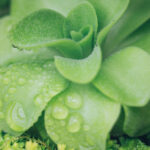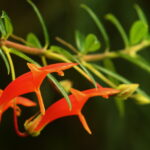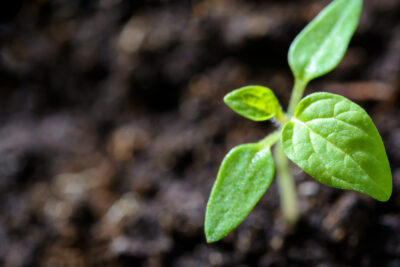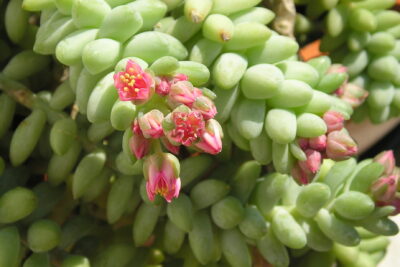
Unusual Colors in Succulent Foliage: Are Pink Leaves Normal?

Succulents have become increasingly popular among plant enthusiasts due to their unique and eye-catching appearance. One of the most intriguing features of these plants is the wide range of colors they can display in their foliage. While green is the most common color, succulents can also have leaves in shades of red, purple, blue, and even pink. However, the presence of pink leaves in succulents often raises questions among growers about whether it is a normal occurrence or a sign of an underlying issue.
We will explore the phenomenon of pink leaves in succulents and shed light on whether it is a normal characteristic or a cause for concern. We will discuss some common succulent varieties that naturally exhibit pink foliage, as well as factors that can influence the coloration of succulent leaves, including environmental conditions and genetic factors. Additionally, we will provide tips on how to care for succulents with pink leaves and how to maintain their vibrant coloration. By the end of this article, you will have a better understanding of the fascinating world of succulent foliage colors, particularly the pink hues that can grace these captivating plants.
- Yes, pink leaves can be normal in some succulent species
- Pink leaves are often a sign of stress or sunburn in succulents
- Providing adequate sunlight and watering can help prevent pink leaves
- Some succulent varieties naturally have pink or colorful foliage
- Pink leaves can also be a sign of nutrient deficiencies in succulents
- Adjusting the soil pH and fertilizing can help correct nutrient deficiencies
- Pink leaves can be temporary and may return to their normal color over time
- If pink leaves persist or worsen, it may indicate a more serious problem with the plant
- Consulting a plant expert or horticulturist can provide further guidance on pink leaves in succulents
- Frequently Asked Questions
Yes, pink leaves can be normal in some succulent species
When it comes to succulent foliage, we often expect shades of green, ranging from pale to dark. However, there are succulent species that break this norm and surprise us with their unique pink leaves. While it may seem unusual, pink foliage can actually be perfectly normal in certain succulents.
One of the most popular succulents with pink leaves is the Echeveria. These stunning plants have rosettes of fleshy leaves that can range in color from pale pink to vibrant magenta. The pink color is caused by pigments called anthocyanins, which are responsible for the pink, purple, and red hues in plants. Anthocyanins are produced in response to various factors, including sunlight exposure, temperature, and stress. So, if you notice pink leaves on your Echeveria, don't worry, it's just a natural variation!
Another succulent known for its pink foliage is the Kalanchoe. This unique plant features thick, paddle-shaped leaves that can turn a beautiful shade of pink under certain conditions. Just like Echeverias, Kalanchoes produce anthocyanins that give their leaves their pink color. The intensity of the pink hue can vary depending on the light levels and overall health of the plant.
If you're looking to add some pink to your succulent collection, consider the Graptopetalum paraguayense, also known as the "Ghost Plant." This succulent has a rosette of thick, pointed leaves that can range from pale pink to a silvery gray-green. The pink coloration in this plant is more pronounced under direct sunlight, making it a stunning addition to any sunny spot in your garden or indoor collection.
 Top Choices: Popular Flowering Succulent House Plants for Your Home
Top Choices: Popular Flowering Succulent House Plants for Your HomeWhy do succulents have pink leaves?
The pink color in succulent leaves serves multiple purposes. First and foremost, it can act as a sunscreen, protecting the plant from excessive sunlight. The anthocyanins in the leaves absorb UV radiation, reducing the risk of damage to the plant's photosynthetic machinery.
Additionally, pink foliage can also be a sign of stress in succulents. When exposed to intense sunlight or extreme temperatures, succulents may produce more anthocyanins as a protective response. This helps them cope with the environmental challenges they face and can help prevent damage to their cells and tissues.
However, it's important to note that not all pink leaves in succulents are normal. In some cases, pink foliage can be a sign of nutrient deficiencies or other underlying issues. If your succulent's leaves turn pink and you suspect it might be due to a problem, it's best to consult a plant expert for guidance.
- Tip: When growing succulents with pink leaves, it's essential to provide them with the right conditions. They generally thrive in bright, indirect light and well-draining soil. Avoid overwatering, as it can lead to root rot and other problems.
- Fun Fact: Some succulent enthusiasts even use pink foliage as a way to identify and name new cultivars!
So, if you come across succulents with pink leaves, don't be surprised. Embrace their uniqueness and enjoy the beauty they bring to your collection.
Pink leaves are often a sign of stress or sunburn in succulents
When it comes to succulent foliage, we often expect to see shades of green, blue, or even purple. So, it's no surprise that pink leaves can catch us off guard. But are pink leaves normal for succulents? The short answer is no. Pink leaves in succulents are usually a sign of stress or sunburn.
Stress can occur due to various factors such as extreme temperatures, overwatering, or inadequate lighting. When succulents are exposed to these unfavorable conditions, they may respond by developing pink or reddish pigmentation in their leaves. This is their way of protecting themselves from further damage.
 Discover a Diverse Selection of Vibrant Colored Succulent Plants
Discover a Diverse Selection of Vibrant Colored Succulent PlantsAnother common cause of pink leaves in succulents is sunburn. Just like humans, succulents can get sunburned if they are exposed to intense sunlight for prolonged periods. The pink or reddish coloration is their way of showing that they've had too much sun. If you notice pink leaves on your succulent, it's essential to move it to a shadier location to prevent further damage.
When to be concerned about pink leaves
While pink leaves are generally a temporary response to stress or sunburn, there are times when they can indicate a more serious problem. If your succulent's leaves are consistently pink or the pink color is accompanied by other signs of distress, such as wilting or rotting, it's crucial to investigate further.
One possible explanation for persistent pink foliage is a nutrient deficiency. Succulents require a balanced diet of macronutrients and micronutrients to thrive. If they are not getting enough essential nutrients, their leaves may turn pink as a result. In such cases, it's advisable to adjust their fertilizer regimen or consult a plant expert for guidance.
In some rare cases, pink leaves can also be a symptom of a viral or fungal infection. If you suspect that your succulent may be infected, it's best to isolate it from other plants and seek professional advice. Prompt action can help prevent the spread of the disease and increase the chances of saving your precious succulent.
While pink leaves may add a touch of uniqueness to your succulent collection, they are not considered normal. In most cases, pink foliage indicates stress or sunburn, and the coloration should fade as the plant recovers. However, if the pink leaves persist or are accompanied by other concerning symptoms, it's important to address the underlying issue promptly. By understanding the causes and potential implications of pink leaves, you can better care for your succulents and ensure their long-term health and beauty.
Providing adequate sunlight and watering can help prevent pink leaves
When it comes to succulent foliage, we often think of shades of green, ranging from pale mint to deep emerald. However, every now and then, succulent enthusiasts may encounter an unexpected burst of color in their plants – pink leaves. While pink foliage may seem unusual, it is not entirely abnormal in the world of succulents.
 Low-Water Succulents: Discovering Thin-Leafed Varieties
Low-Water Succulents: Discovering Thin-Leafed VarietiesUnderstanding Pink Foliage in Succulents
There are several factors that can contribute to the appearance of pink leaves in succulents. One of the main reasons is stress. Just like humans, plants can experience stress too. Exposure to excessive sunlight or extreme temperatures can cause succulents to display pink hues as a response to the stress they are experiencing. In some cases, insufficient watering or improper nutrition can also lead to pink foliage.
Preventing Pink Leaves
If you prefer your succulents to maintain their classic green color, there are a few steps you can take to prevent the occurrence of pink leaves. Firstly, ensure that your succulents are receiving the appropriate amount of sunlight. While succulents thrive in bright light, too much direct sunlight can cause stress and trigger the development of pink foliage. Consider providing some shade during the hottest parts of the day, especially in regions with intense sunlight.
Secondly, it is crucial to water your succulents properly. Overwatering can lead to root rot and other issues, which can manifest as pink leaves. Make sure you allow the soil to dry out completely between waterings, as succulents are adapted to survive in arid conditions. Additionally, using well-draining soil and pots with drainage holes can help prevent waterlogged roots that may contribute to the development of pink leaves.
Embracing Pink Leaves
While pink foliage may not be the norm for succulents, it can add a unique and eye-catching touch to your plant collection. Some succulent varieties, such as Echeveria 'Perle Von Nurnberg' or Graptopetalum paraguayense 'Ghost Plant', naturally exhibit pink hues even under optimal conditions. If you find yourself with pink leaves, embrace their beauty and consider it as a natural variation within the succulent world.
 Unveiling the Special Qualities of Dolphin Succulent
Unveiling the Special Qualities of Dolphin SucculentPink leaves in succulents can be both a normal occurrence and a response to stress. By providing adequate sunlight, proper watering, and a suitable growing environment, you can minimize the chances of your succulents developing pink foliage. However, if you do come across pink leaves, don't fret! Embrace the uniqueness and appreciate the unexpected beauty it brings to your succulent collection.
Some succulent varieties naturally have pink or colorful foliage
When you think of succulents, you might envision plants with green or gray leaves. However, there are actually some succulent varieties that have pink or colorful foliage, which can add a unique and eye-catching touch to your garden or indoor space.
While pink leaves may seem unusual, they are actually quite normal for certain types of succulents. These plants have evolved to produce pigments that give their leaves vibrant colors, including shades of pink.
Here are a few succulent varieties known for their pink foliage:
- Echeveria 'Perle von Nürnberg': This popular succulent features powdery pink leaves with a hint of purple. It forms rosettes that can grow up to 6 inches in diameter.
- Kalanchoe luciae: Also known as "Flapjack" or "Paddle Plant," this succulent has thick, flat leaves that turn a striking shade of pink or reddish-brown when exposed to bright sunlight.
- Graptosedum 'Alpenglow': With its rosettes of pinkish-orange leaves, this succulent adds a warm and soft touch to any arrangement.
While pink leaves are not a sign of any particular problem or disease, it is important to note that the intensity of the color can vary depending on factors such as sunlight exposure, temperature, and the overall health of the plant.
If you are interested in adding succulents with pink foliage to your collection, it is essential to provide them with proper care. These plants typically thrive in well-draining soil, bright light, and moderate watering. They are also generally more suited to warmer climates.
Whether you choose succulents with pink leaves or stick to the traditional green ones, incorporating these unique plants into your garden or indoor space can bring a touch of charm and beauty. Don't be afraid to experiment with different colors and varieties to create your own succulent paradise!
 Introducing Our Lime Green Succulent: A Perfect Addition!
Introducing Our Lime Green Succulent: A Perfect Addition!Pink leaves can also be a sign of nutrient deficiencies in succulents
When it comes to succulent foliage, we often expect to see shades of green, ranging from light lime to deep emerald. However, every now and then, you may come across succulents with pink leaves. This unexpected burst of color can pique your curiosity and leave you wondering if pink leaves are normal in succulents.
While pink leaves are not as common as green ones in succulents, they are not necessarily abnormal. In fact, there are several factors that can cause succulent foliage to turn pink.
Natural Variations
In some cases, pink leaves can simply be a result of natural variations within the species. Just like humans can have different hair colors or eye colors, succulents can also display variations in their leaf coloration. Some succulents naturally produce pink pigments in their leaves, giving them a unique and eye-catching appearance.
Stress Response
Another reason for pink leaves in succulents is a stress response. Succulents are known for their ability to adapt and survive in harsh conditions. When exposed to extreme temperatures, intense sunlight, or inadequate water, succulents may respond by producing pink pigments as a way to protect themselves from further damage. This stress-induced color change is often temporary and the leaves may revert back to their original color once the stressor is removed.
Nutrient Deficiencies
Pink leaves can also be a sign of nutrient deficiencies in succulents. Just like any other plant, succulents require a balanced supply of nutrients to thrive. If a succulent is lacking certain essential nutrients, such as nitrogen or phosphorus, it may start displaying pink or reddish hues in its leaves. However, it's important to note that nutrient deficiencies can be detrimental to the overall health of the succulent, so it's crucial to address and correct any deficiencies promptly.
To conclude, pink leaves in succulents can be both normal and a cause for concern. While they can be a natural variation or a temporary stress response, they can also indicate nutrient deficiencies. If you notice pink leaves in your succulents, it's worth investigating further to determine the underlying cause and take appropriate action to ensure the health and well-being of your plants.
 Succulent Growth Habits: Tall or Compact?
Succulent Growth Habits: Tall or Compact?Adjusting the soil pH and fertilizing can help correct nutrient deficiencies
Adjusting the soil pH
If you notice that your succulent's foliage is turning pink, it could be an indication of a nutrient deficiency. One possible cause is an imbalance in the soil pH. Most succulents prefer a slightly acidic to neutral pH level, ranging from 6.0 to 7.0. If the pH is too high or too low, it can affect the plant's ability to absorb nutrients properly.
To adjust the soil pH, you can add amendments such as sulfur or lime. If your soil pH is too high (alkaline), adding sulfur can help lower it. On the other hand, if your soil pH is too low (acidic), applying lime can raise it. It is essential to follow the recommended application rates for these amendments and monitor the pH levels periodically to ensure they stay within the optimal range.
Fertilizing to correct nutrient deficiencies
Another factor that can lead to pink foliage in succulents is nutrient deficiencies. Succulents require specific nutrients to maintain their vibrant colors and healthy growth. If your plant is lacking essential nutrients, it may exhibit unusual coloration, including pink leaves.
Using a balanced fertilizer specifically formulated for succulents can help correct nutrient deficiencies. Look for a fertilizer with a ratio of N-P-K (nitrogen, phosphorus, and potassium) that suits your succulent's needs. Additionally, some fertilizers also contain trace elements like iron, manganese, and magnesium, which can address specific nutrient deficiencies.
Monitoring and adjusting nutrient levels
Regularly monitoring the nutrient levels in your succulent's soil is crucial for maintaining healthy foliage. Soil testing kits are available for home gardeners and provide accurate readings of nutrient levels. By conducting these tests, you can identify any deficiencies and adjust the fertilization accordingly.
It's important to note that over-fertilization can be detrimental to succulents, so always follow the recommended application rates. Excess fertilizer salts can accumulate in the soil, leading to root burn and potential plant damage. Therefore, it's essential to strike a balance when fertilizing your succulents.
 Top Heat-Loving Succulents: Perfect for Campfire Conditions
Top Heat-Loving Succulents: Perfect for Campfire ConditionsRemember, while pink leaves in succulents may seem unusual, they can be an indication of nutrient deficiencies. By adjusting the soil pH and fertilizing with the appropriate nutrients, you can help your succulents regain their natural vibrant colors and thrive.
Pink leaves can be temporary and may return to their normal color over time
When it comes to succulent foliage, we often expect to see shades of green, blue, or even purple. But what about pink leaves? Are they normal or a cause for concern? The answer is not so straightforward.
Temporary phenomenon:
Firstly, it's important to note that pink leaves in succulents can be a temporary phenomenon. Sometimes, environmental factors such as stress, temperature fluctuations, or excessive sunlight exposure can cause the leaves to temporarily turn pink. This is often a defense mechanism employed by the plant to protect itself from potential damage.
Reversion to normal color:
In most cases, succulent leaves that have turned pink will gradually revert to their normal color over time. As the plant adapts to its surroundings and recovers from any stress or damage, the pink hues will fade away, and the leaves will regain their typical green coloration.
 Popular Chalk Stick Succulents: Exploring Varieties and Names
Popular Chalk Stick Succulents: Exploring Varieties and NamesGenetic variation:
However, it's worth mentioning that some succulent species do naturally exhibit pink foliage as part of their genetic makeup. These plants have evolved to produce pigments that result in pink or reddish leaves, which can add a unique and eye-catching element to your succulent collection.
Factors to consider:
If you notice pink leaves on your succulent, it's essential to assess the overall health of the plant. Check for signs of pests, diseases, or nutrient deficiencies that could be causing the color change. Additionally, evaluate the growing conditions and make sure they are suitable for your succulent's specific needs.
Taking care of pink-leaved succulents:
If you have a succulent with naturally pink foliage, it's crucial to provide the right care to maintain its vibrant color. These plants typically thrive in bright, indirect sunlight and well-draining soil. Avoid overwatering, as excessive moisture can lead to root rot and damage the plant's health.
In conclusion:
 Succulent Flowers: A Complete Guide to Blooming Beauty
Succulent Flowers: A Complete Guide to Blooming BeautyPink leaves in succulents can be both a temporary response to environmental factors or a natural feature of certain species. By understanding the underlying causes and providing appropriate care, you can enjoy the beauty and diversity of pink foliage in your succulent collection.
If pink leaves persist or worsen, it may indicate a more serious problem with the plant
When it comes to succulent foliage, we are accustomed to seeing various shades of green. However, sometimes we come across a succulent with pink leaves, which can be quite surprising. While pink leaves may catch our attention and add a unique touch to the overall appearance of the plant, it is important to determine whether this is a normal occurrence or a sign of an underlying issue.
Are pink leaves normal?
Yes, in some cases, pink leaves can be a normal part of a succulent's growth and development. Some succulent species naturally produce pink leaves, especially during certain seasons or under specific environmental conditions. These pink hues can range from soft pastel shades to vibrant and eye-catching colors. So, if your succulent is displaying pink leaves and appears healthy otherwise, there is no need to worry.
What causes pink leaves in succulents?
Pink leaves in succulents can be caused by a variety of factors, including:
 The Rare Succulent: Uncovering Its Unique Qualities
The Rare Succulent: Uncovering Its Unique Qualities- Sunlight exposure: Increased exposure to bright sunlight can intensify the pigmentation in succulent leaves, resulting in pink hues.
- Stress: Environmental stressors such as extreme temperatures or insufficient watering can cause succulents to produce pink leaves as a response.
- Genetics: Some succulent species naturally have pigments that give their leaves a pink coloration.
- Nutrient deficiency: Lack of certain essential nutrients, such as phosphorus or iron, can lead to pink discoloration in succulent leaves.
When should you be concerned?
While pink leaves can be normal, persistent or worsening pink discoloration may indicate an underlying problem. If your succulent's pink leaves are accompanied by other symptoms such as wilting, yellowing, or rotting, it is crucial to investigate further. These symptoms could be signs of diseases, pests, or root issues that require prompt attention and appropriate treatment.
Conclusion
Pink leaves in succulents can add a touch of uniqueness and beauty to your collection. In most cases, they are a normal and harmless occurrence. However, if the pink coloration persists or worsens, it is essential to assess the overall health of the plant and address any potential issues. Regular observation, proper care, and timely intervention can help ensure the longevity and vibrancy of your succulent collection.
Consulting a plant expert or horticulturist can provide further guidance on pink leaves in succulents
If you've ever come across a succulent with pink leaves, you may be wondering if this is a normal occurrence or something to be concerned about. The answer is, it depends. While most succulents have leaves that range in shades of green, there are some varieties that exhibit unusual colors, such as pink.
It's important to note that not all pink leaves in succulents are a cause for alarm. In fact, some succulents naturally develop pink leaves as part of their growth cycle or as a response to certain environmental conditions. However, it's always a good idea to consult a plant expert or horticulturist if you notice any drastic changes in your succulent's foliage.
Why do some succulents have pink leaves?
The presence of pink leaves in succulents can be attributed to a few different factors:
- Pigmentation: Pink pigmentation in succulent leaves can be the result of anthocyanin pigments. These pigments are responsible for giving plants their red, purple, or pink hues. The intensity of the pink color can vary depending on the amount and distribution of anthocyanin pigments in the leaves.
- Light exposure: Pink leaves in succulents can also be a response to sun exposure. Some succulents develop pink or reddish hues in their leaves when exposed to intense sunlight. This is a natural protective mechanism that helps to shield the plant from excessive light and heat.
- Stress or damage: Sometimes, pink leaves in succulents can be a sign of stress or damage. Overexposure to sunlight, extreme temperatures, or improper watering can cause succulent leaves to turn pink. In these cases, it's important to assess the growing conditions and make any necessary adjustments to ensure the plant's health.
Examples of succulents with pink leaves
There are several succulent varieties that are known for their pink foliage. Here are a few examples:
- Echeveria 'Pink Frills': This succulent features rosettes of frilly, pink-tipped leaves. It adds a touch of elegance to any succulent collection.
- Graptosedum 'California Sunset': With its pink and peach-colored leaves, this succulent resembles a beautiful sunset. It adds a pop of color to any garden or arrangement.
- Kalanchoe tomentosa 'Chocolate Soldier': Although primarily known for its fuzzy, chocolate-colored leaves, this succulent can also develop pink edges under certain conditions.
Remember, while pink leaves in succulents can be eye-catching and unique, it's important to monitor their overall health and provide them with the proper care they need. By consulting a plant expert or horticulturist, you can ensure that your succulents thrive and continue to display their beautiful pink foliage.
Frequently Asked Questions
1. Can succulents have pink leaves?
Yes, some succulents can have pink leaves. It is a natural variation in foliage color and can be considered normal.
2. What causes succulent leaves to turn pink?
The pink color in succulent leaves is often caused by pigments called anthocyanins, which are influenced by factors like sunlight, temperature, and stress.
3. Are pink leaves a sign of a healthy succulent?
Yes, pink leaves can be a sign of a healthy succulent. However, it is important to ensure that the plant is receiving adequate sunlight and water to maintain its overall health.
4. Can I propagate succulents with pink leaves?
Yes, succulents with pink leaves can be propagated through various methods such as leaf cuttings or stem cuttings, just like succulents with any other foliage color.
If you want to read more articles similar to Unusual Colors in Succulent Foliage: Are Pink Leaves Normal?, you can visit the Varieties and Colors category.






You Must Read